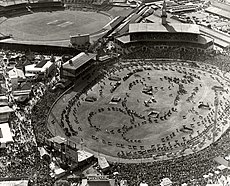Sydney Showground Speedway
| Speedway Royale Speedway Royal The Royale |
|
|---|---|

Sydney Showground during the 1936 Sydney Royal Easter Show. The speedways start/finish line was located at the right of the picture.
|
|
| Location | Moore Park, New South Wales |
| Coordinates | 33°53′36″S 151°13′37″E / 33.89333°S 151.22694°ECoordinates: 33°53′36″S 151°13′37″E / 33.89333°S 151.22694°E |
| Capacity | 40,000 |
| Owner | New South Wales Government |
| Operator |
Royal Agricultural Society of NSW (showground) Empire Speedways (speedway) |
| Broke ground | 1882 |
| Opened | 1882 (showground) 1926 (speedway) |
| Closed | 1996 |
| Major events |
Australian Sprintcar Championship Australian Speedcar Championship Australian Speedcar Grand Prix Australian Solo Championship Australian Sidecar Championship Australasian Solo Final |
| Oval | |
| Surface | dolomite |
| Length | 0.316 mi (0.509 km) |
| Lap record | 0:16.876 (Jay Drake ( |
Sydney Showground Speedway, originally known as the Speedway Royal and later the Speedway Royale but often referred to as just The Royale or The Showground, was a dirt Dirt track racing venue at the old Sydney Showground used from 1926 until 1996.
In 1937, The Showground was claimed to the fastest speedway in the world by the tracks promoters. The 509 metres (557 yards) egg shaped track was also the site of some spectacular crashes, some unfortunate deaths and a lot of spectacular racing. Although solos were first to race at the showground on 21 July 1926, they were soon joined by sidecars and Speedcars (also known as Midgets but called Speedcars in Australia). In the 1950s began to appear joined much later by demolition derbies and jumping motorcycles over buses and the Royale would attract huge spectator attendance.
The track had a dolomite surface, which the speedway drivers and riders continually asked the owners, the Royal Agricultural Society of NSW, to mix in shale and clay (as used on tracks in England such as Wembley) to improve traction but this never happened. A long stated reason for this was that the Showground was also used year-round as a harness racing venue (though this excuse wore thin after the 'trotts' moved permanently to the Harold Park Paceway in the late 1940s). The only other major complaint about the track itself was that it was very narrow compared to other speedways. Where most tracks allowed three wide racing even in the corners, at the Showground there was barely enough room for two cars.
The speedway's pits were located under the Martin & Angus Stand at the southern end of the track. This created a unique atmosphere with the place often filling with cigarette smoke and the smell of oil and petrol. Former dual Rugby international and part-time announcer at the speedway Rex Mossop once described the pits at the Royale as being like "Dantino's Inferno".
The start / finish line at the Showground was on the eastern side of the track in front of the Suttor Stand. Running anti-clockwise as most speedway divisions do, the track then moved into the Bull Pens for turn 1, so called as this was where the cattle would enter the arena during the Royal Easter Show. The track announcers box was located close to the track above the Bull Pens. They then continued past the double decked Members Stand and the famous clock tower sitting on the roof, and into what riders called "The Armpit", a tight turn leading onto the back straight where the Coronation Stand stood. Turns 3 and 4 went past Martin & Angus Stand and the pits before passing the Sinclair Stand in turn 4 and coming onto the main straight to finish the lap.
...
Wikipedia
